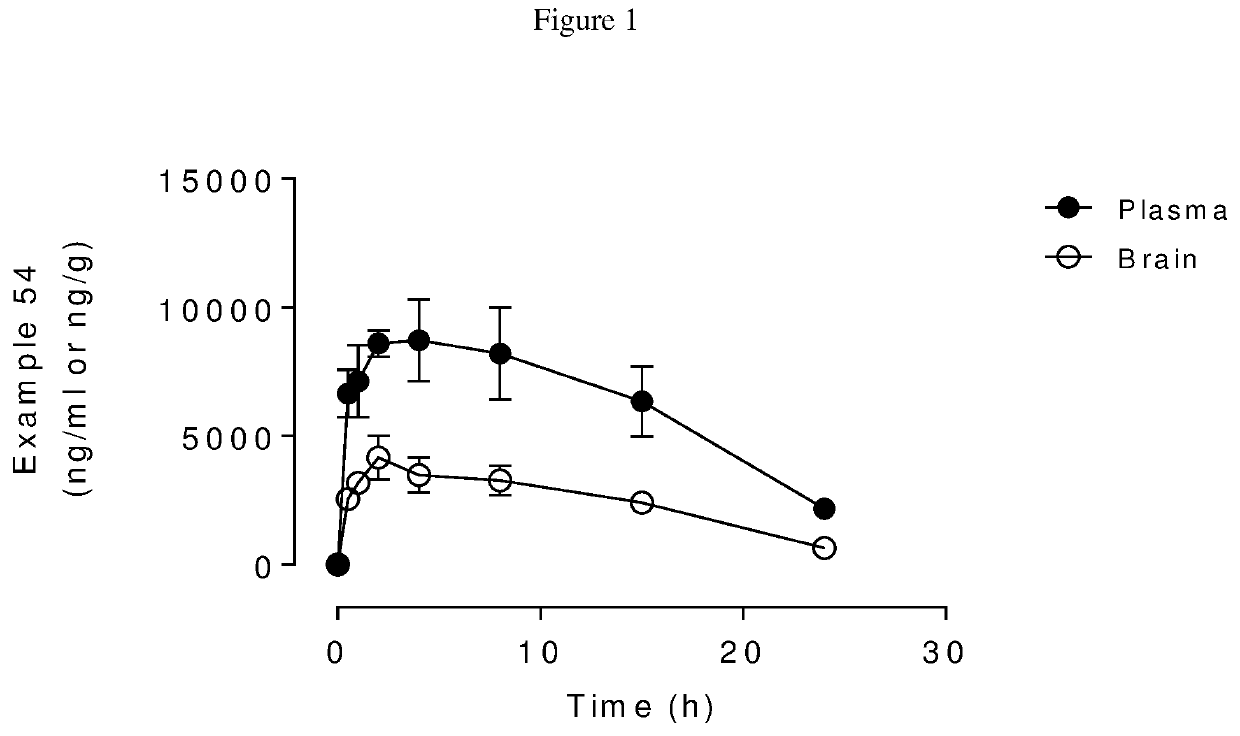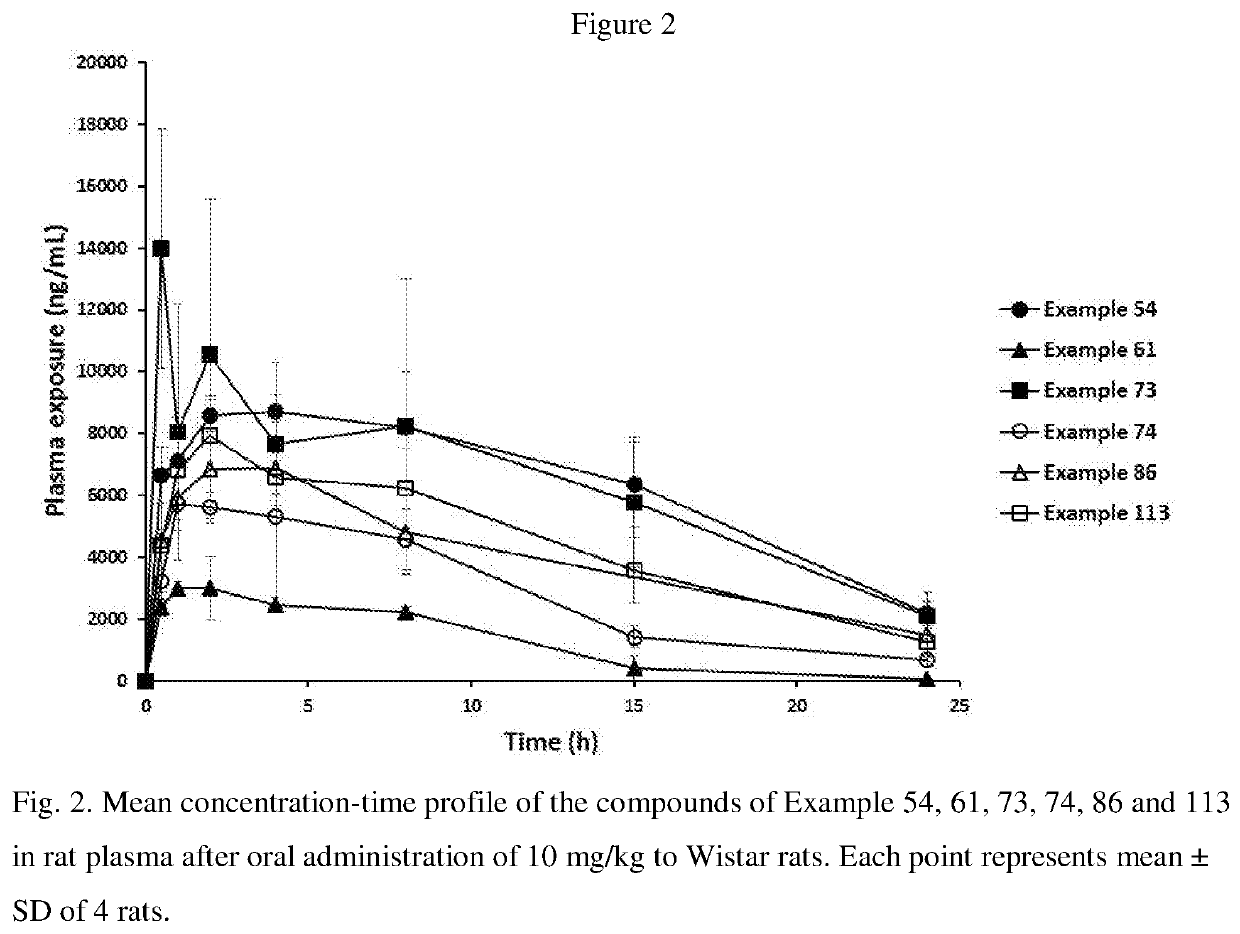Blood-brain barrier-penetrant dopamine-b-hydroxylase inhibitors
a blood-brain barrier and inhibitor technology, applied in the field of dopaminehydroxylase inhibitors, can solve the problems of unfavorable cardiovascular system or systemic tissue secondary effects, impaired cognition, and sympathetic driv
- Summary
- Abstract
- Description
- Claims
- Application Information
AI Technical Summary
Benefits of technology
Problems solved by technology
Method used
Image
Examples
example 1
yrrolidine-1-carbothioamide
Step 1: N-(3-phenylpyrrolidine-1-carbonothioyl)benzamide
[0301]
[0302]To a solution of ammonium thiocyanate (62 mg, 0.815 mmol) in acetone (2 mL) was added benzoyl chloride (0.087 mL, 0.747 mmol) at room temperature with stirring. After being stirred for 10 min. the resulting precipitate was filtered off and 3-phenylpyrrolidine (CAS#936-44-7) (100 mg, 0.679 mmol) was added to the filtrate in portions. The reaction mixture was stirred at ambient temperature for 20 h, and then evaporated to dryness. Chromatography (petroleum ether-ethyl acetate, 4:1) gave N-(3-phenylpyrrolidine-1-carbonothioyl)benzamide as an off-white powder (0.067 g, 32% yield).
Step 2: 3-phenylpyrrolidine-1-carbothioamide
[0303]
[0304]To a solution of N-(3-phenylpyrrolidine-1-carbonothioyl)benzamide (0.06 g, 0.193 mmol) in methanol (2 mL) was added 20% aq. sodium hydroxide (0.317 mL, 1.933 mmol) and the mixture was refluxed for 6 h. Thereupon, the reaction was diluted with water (4 mL) and the...
example 2
en-2-yl)pyrrolidine-1-carbothioamide
[0306]
[0307]3-(Thiophen-2-yl)pyrrolidine (CAS#125067-53-0) was converted to 3-(thiophen-2-yl)pyrrolidine-1-carbothioamide by a similar procedure as described for Example 1 and the product was isolated as an off-white powder.
[0308]1H NMR (DMSO-d6): 7.39 (1H, d, J=4.4 Hz), 7.19 (2H, br, s), 6.98 (1H, dd, J=5.0, 3.5 Hz), 6.96 (1H, d, J=2.9 Hz), 4.10 (0.5H, br s), 3.86 (0.5H, br s), 3.80 (1H, br s), 3.66 (0.5H, br s), 3.53 (1.5H, m), 3.38 (0.5H, m), 3.29 (0.5H, br s), 2.39 (0.5H, m), 2.26 (0.5H, br s), 2.09 (0.5H, br s), 1.95 (0.5H, br s). 13C NMR (DMSO-d6): 178.5, 144.7, 127, 124.1, 124.1, 124, 58.1, 54.6, 51, 47.2, 39.2, 37.9, 34.1, 33.0.
example 3
rophenyl)pyrrolidine-1-carbothioamide
[0309]
[0310]To a solution of 1,1′-thiocarbonyldiimidazole (0.570 g, 3.20 mmol) in tetrahydrofuran (6 mL) was added a solution of 3-(4-fluorophenyl)pyrrolidine (CAS#144620-11-1) (0.48 g, 2.91 mmol) in tetrahydrofuran (6.00 mL). The mixture was then stirred for 1 h at room temperature and for an additional 2 h at 55-60° C. Thereupon, tetrahydrofuran was removed under vacuum and the residue was dissolved in methanol (12 mL). The thus obtained solution was treated with 25% aq. ammonia (3.26 mL, 43.6 mmol) and then the mixture was stirred at room temperature for 5 days. The reaction was diluted with IM HCl, the resulting precipitate was collected, washed with a mixture of methanol-water (1:1) and dried under vacuum at 50° C. to give 3-(4-fluorophenyl)pyrrolidine-1-carbothioamide as a white powder (0.22 g, 34% yield).
[0311]1H NMR (DMSO-d6): 7.33 (2H, m), 7.15 (2H, m), 6.70-7.60 (2H, br s), 4.11 (0.5H, m), 3.90 (0.5H, m), 3.77 (0.5H, m), 3.52 (1.5H, m),...
PUM
| Property | Measurement | Unit |
|---|---|---|
| Fraction | aaaaa | aaaaa |
| Structure | aaaaa | aaaaa |
Abstract
Description
Claims
Application Information
 Login to View More
Login to View More - R&D
- Intellectual Property
- Life Sciences
- Materials
- Tech Scout
- Unparalleled Data Quality
- Higher Quality Content
- 60% Fewer Hallucinations
Browse by: Latest US Patents, China's latest patents, Technical Efficacy Thesaurus, Application Domain, Technology Topic, Popular Technical Reports.
© 2025 PatSnap. All rights reserved.Legal|Privacy policy|Modern Slavery Act Transparency Statement|Sitemap|About US| Contact US: help@patsnap.com



